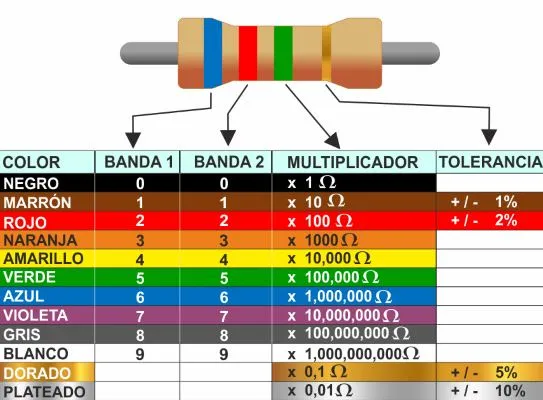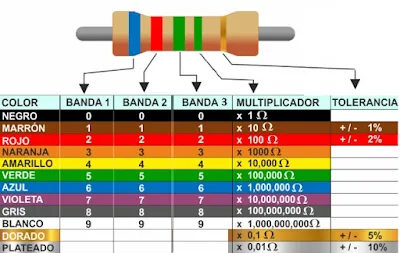Este código de colores fue creado los primeros años de la década de 1920 Si el valor de **la resistencia estuviera impreso (tanto texto o como puntos de color) sobre un cuerpo cilíndrico, al soldarlos el valor podría quedar oculto. Por ello y para poder ver bien su valor desde cualquier dirección, pasó a ser codificado con franjas anulares de color. **
Vamos a ver como descubrir el valor de las resistencias según las cantidad de bandas y sus colores.

Las resistencias mas comunes hoy en día son de 4 bandas y realmente es muy fácil de averiguar su valor conociendo el famoso código de colores que tenemos a continuación:
banda 1 primer dígito significativo
banda 2 segundo dígito significativo
banda 3 Multiplicador
banda 4 Tolerancia (con este valor el fabricante nos dice un porcentaje de error que pueda tener esa resistencia mas menos 10% (plateado) por ejemplo , cuanto mas chico sea este valor , mas precisión en el valor tendrá nuestra resistencia)
Por ejemplo: la resistencia de la figura es azul-rojo-verde-dorado
la primer banda (marron) 1
la segunda banda (rojo) 2
la tercera banda (naranja) x1000 multiplicador
la cuarta banda (dorado) mas menos 5 %
Entonces esta resistencia vale 12 x 1000 = 12000 ohms = 12K
Con una tolerancia de 5% el fabricante dice que esta resistencia de 12K puede estar 5% por encima de su valor o 5% por debajo de su valor
(entre 12600 ohms y 11400 ohms)
Nota: Si la resistencia no tuviera banda de tolerancia quiere decir que la tolerancia de esa resistencia es de 20%
Nota: si la tercera banda que es la multiplicadora fuera dorado o plateado , como por ejemplo
rojo-rojo-dorado-dorado el valor seria 22 x 0,1 = 2,2 ohms con una tolerancia de 5%

También tenemos resistencias de 5 bandas , las cuales son prácticamente iguales solo que las tres primeras bandas nos van a dar el numero significativo , luego el multiplicador y por ultimo la tolerancia.
banda 1 primer dígito significativo
banda 2 segundo dígito significativo
banda 3 tercer dígito significativo
banda 3 Multiplicador
banda 4 Tolerancia
Ejemplo:
Azul-rojo-verde-verde-dorado
625 x 100000 = 62500000 ohms = 62,5 Mohms con una tolerancia de 5%
Nota: Por ultimo hay muchas resistencias que capaz no tengan ni 4 bandas ni 5 bandas o tal vez no se puedan distinguir bien los colores que tiene por lo tanto la mejor forma y mas eficaz de conocer el valor de una resistencia es midiéndola con el tester y vamos a tener el valor real de la resistencia.
Nos quedaría hablar de la potencia que puede disipar cada resistencia, pero esto no tiene nada que ver con el código de colores ni con el valor ohmico de la resistencia en si, esta relacionada con el tamaño de la resistencia , cuanto mas tamaño tiene , mas potencia puede disipar.
.......................................................................................................
This color code was created in the early years of the 1920s. If the value of the resistor were printed (either as text or color dots) on a cylindrical body, when soldering them, the value could be hidden. Therefore, in order to clearly see its value from any direction, it was encoded with concentric color bands. Let's see how to determine the value of resistors based on the number of bands and their colors

The most common resistors nowadays have 4 bands, and it's really easy to determine their value by knowing the famous color code we have below:
Band 1: First significant digit
Band 2: Second significant digit
Band 3: Multiplier
Band 4: Tolerance (with this value, the manufacturer tells us a percentage of error that the resistor may have, typically ±10% (silver), for example. The smaller this value is, the more precise the resistor's value will be.)
For example: the resistor in the figure is blue-red-green-gold.
The first band (brown) is 1.
The second band (red) is 2.
The third band (orange) is a multiplier of x1000.
The fourth band (gold) indicates a tolerance of ±5%.
So, this resistor is worth 12 x 1000 = 12,000 ohms = 12K.
With a tolerance of 5%, the manufacturer states that this 12K resistor can be 5% above or below its value (between 12,600 ohms and 11,400 ohms).
Note: If the resistor doesn't have a tolerance band, it means the tolerance of that resistor is 20%.
Note: If the third band, which is the multiplier, is gold or silver, for example, red-red-gold-gold, the value would be 22 x 0.1 = 2.2 ohms with a tolerance of 5%.

We also have resistors with 5 bands, which are practically the same except that the first three bands give us the significant number, then the multiplier, and finally the tolerance.
Band 1: First significant digit
Band 2: Second significant digit
Band 3: Third significant digit
Band 4: Multiplier
Band 5: Tolerance
Example:
Blue-red-green-green-gold
625 x 100000 = 62,500,000 ohms = 62.5 Mohms with a tolerance of 5%.
**Note: Finally, there are many resistors that may not have either 4 bands or 5 bands, or perhaps the colors cannot be distinguished well. Therefore, the best and most effective way to determine the value of a resistor is by measuring it with a tester, and we will have the actual value of the resistor.
We would also talk about the power that each resistor can dissipate, but this has nothing to do with the color code or the ohmic value of the resistor itself; it is related to the size of the resistor. The larger the size, the more power it can dissipate.